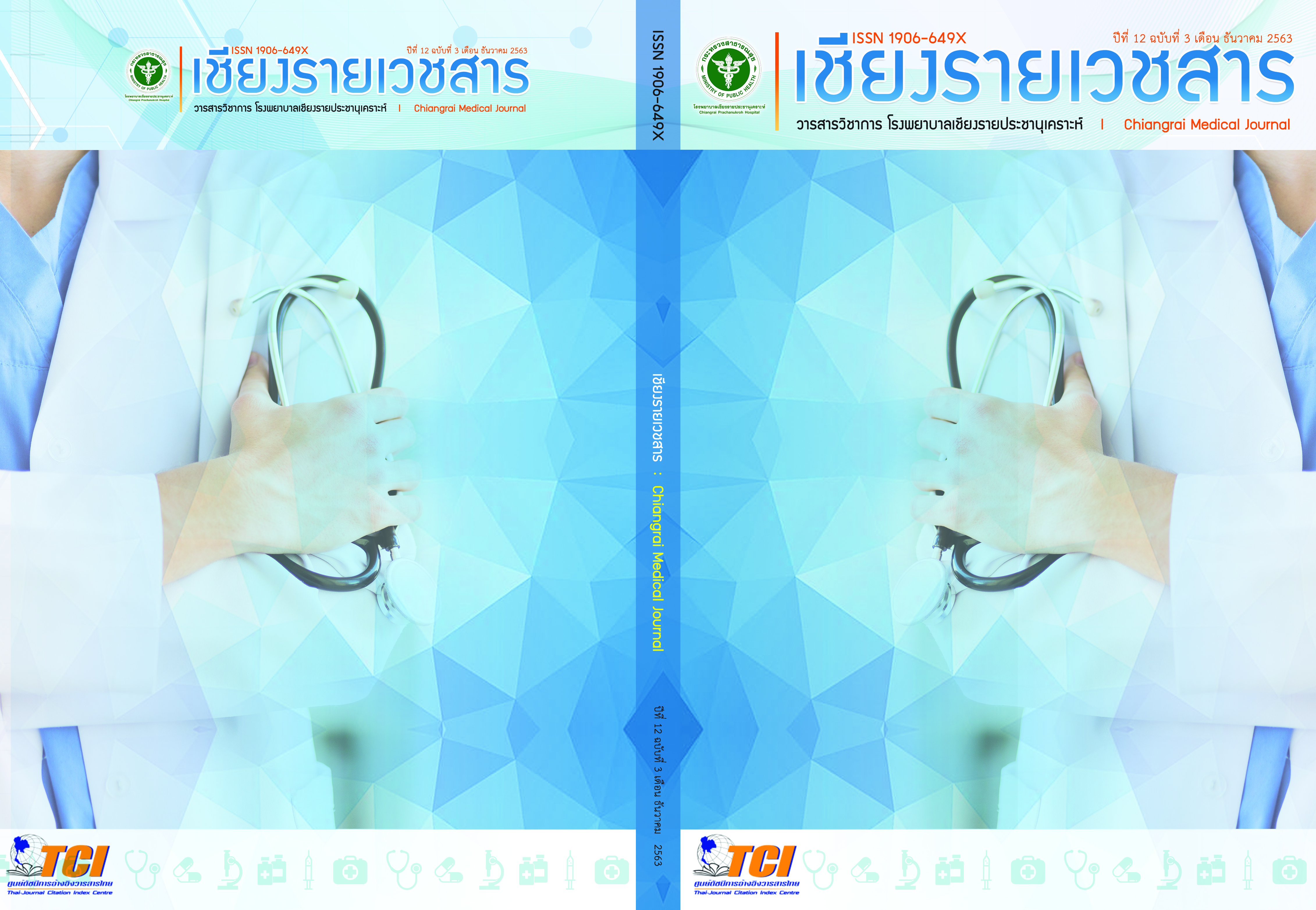การเปรียบเทียบการเกิดความคลาดเคลื่อนทางยา ระหว่างระบบสั่งจ่ายยาแบบใหม่ กับระบบสั่งจ่ายยาแบบเดิม ในผู้ป่วยนอก โรงพยาบาลชัยภูมิ
Main Article Content
บทคัดย่อ
ความสำคัญ: โรงพยาบาลชัยภูมิเปลี่ยนแปลงระบบการสั่งใช้ยาผู้ป่วยนอกของโรงพยาบาล โดยใช้ระบบสั่งจ่ายยาแบบใหม่ที่ใช้ระบบการสั่งจ่ายยาทางคอมพิวเตอร์ โดยไม่มีการพิมพ์รายการยา แทนการสั่งจ่ายยาระบบเดิมที่มีการใช้ใบสั่งยา และมีการคัดลอกคำสั่งใช้ยาร่วม การทราบข้อมูลความคลาดเคลื่อนทางยา หลังจากการเปลี่ยนระบบสั่งจ่ายยาจะเป็นแนวทางในการปรับปรุง พัฒนาการบริการผู้ป่วยนอกให้เหมาะสม อีกทั้งยังเป็นข้อมูลอ้างอิงให้กับโรงพยาบาลอื่นๆต่อไป
วัตถุประสงค์: เพื่อศึกษาความคลาดเคลื่อนทางยาระหว่างระบบสั่งจ่ายยาแบบใหม่ กับระบบสั่งจ่ายยาแบบเดิมในผู้ป่วยนอก โรงพยาบาลชัยภูมิ
วิธีการศึกษา: เป็นการศึกษาย้อนหลัง โดยนำข้อมูลการเกิดความคลาดเคลื่อนทางยา จากระบบสั่งจ่ายยาแบบใหม่ เปรียบเทียบกับระบบสั่งจ่ายยาแบบเดิม โดยรวบรวมข้อมูลการสั่งใช้ยาในวันและเวลาราชการทุกวัน จำแนกตามวันทำการ จากระบบเดิมวันที่ 1 พฤศจิกายน – 31 ธันวาคม 2561 และระบบใหม่วันที่ 1 พฤศจิกายน – 31 ธันวาคม 2562 วิเคราะห์ข้อมูลด้วยสถิติพรรณนา และสถิติอนุมาน ได้แก่ Independent T-test, Mann-Whitney test และ Chi square test
ผลการศึกษา: การเกิดความคลาดเคลื่อนในการสั่งใช้ยา และความคลาดเคลื่อนในการคัดลอกคำสั่งใช้ยาโดยระบบเดิมแตกต่างจากระบบใหม่อย่างมีนัยสำคัญทางสถิติ (13.59±5.01 VS. 10.63±4.84 ครั้งต่อวัน, p=0.008 และ 0.51±0.84 VS. 0.02±0.16 ครั้งต่อวัน, p<0.001 ตามลำดับ) ส่วนการเกิดความคลาดเคลื่อนในการจ่ายยาของระบบสั่งจ่ายยาทั้งสองแบบไม่มีความแตกต่างกันทางสถิติ (0.07±0.35 VS. 0.02±0.16 ครั้งต่อวัน, p=0.549) ความถี่ของการเกิดความคลาดเคลื่อนในการสั่งใช้ยาด้วยระบบสั่งจ่ายยาแบบเดิม และระบบใหม่แตกต่างกันอย่างมีนัยสำคัญ (454 VS. 309 ครั้ง, p<0.001)
สรุปและข้อเสนอแนะ: ระบบสั่งจ่ายยาแบบใหม่ช่วยลดขั้นตอน และการเกิดความคลาดเคลื่อนในการคัดลอกคำสั่งใช้ยา อีกทั้งช่วยให้ความคลาดเคลื่อนในการสั่งใช้ยาของแพทย์ลดลงจากระบบสั่งจ่ายยาโดยใช้ใบสั่งยาแบบเดิมได้ จึงควรสนับสนุนให้มีการใช้ระบบสั่งจ่ายยาแบบใหม่ในผู้ป่วยนอกโรงพยาบาลชัยภูมิ และโรงพยาบาลอื่นๆ ต่อไป
Article Details
References
REFERENCES
Chaiyaphum hospital’s medical record department. Annual report 2019 of medical record in Chaiyaphum hospital. Chaiyaphum: The Hospital; 2019.
Chaiyaphum hospital’s medication error committee. Annual report 2019 of medication error in Chaiyaphum hospital. Chaiyaphum: The Hospital; 2019.
Outpatient pharmacy department. Annual report 2019 of predispensing error in outpatient Chaiyaphum hospital. Chaiyaphum: The Hospital; 2019.
American Society of Hospital Pharmacists. ASHP guidelines on preventing medication errors in hospitals. Am J Hosp Pharm .1993; 50(2):305–14.
van Doormaal JE, van den Bemt PM, Zaal RJ, Egberts AC, Lenderink BW, Kosterink JG, et al. The influence that electronic prescribing has on medication errors and preventable adverse drug events: an interrupted time-series study. J Am Med Inform Assoc. 2009; 16(6): 816-25.
Kopp BJ, Erstad BL, Allen ME, Theodorou AA, Priestley G. Medication errors and adverse drug events in an intensive care unit: direct observation approach for detection. Crit Care Med 2006; 34(2): 415-25.
Han YY, Carcillo JA, Venkataraman ST, Clark RS, Watson RS, Nguyen TC, et al. Unexpected increase mortality after implementation of a commercially sold computerized physician order entry system. Pediatrics.2005; 116(6): 1506-12.
Reckmann MH, Westbrook JI, Koh Y, Lo C, Day RO. Dose computerized provider order entry reduce prescribing errors for hospital inpatients? A systematic review. JAMIA .2009; 16(5): 613-23.
Nualsri A. Medication errors and in-patient computerized prescribing system. Songkhla Med J.2006; 24(1): 1-8.
Pulhnay A. Study of causal factors related to incidence of medication error from medical personnel in Nakhon Thai Crown Prince Hospital, Nakhon Thai district, Phitsanulok province [dissertation]. Phitsanulok: Naresuan University; 2009.
Songkramsri S, Laopaiboon M. Computerized prescribing for reducing prescription errors in Nonghan Hospital, Udonthani province; Interrupted time system series design. IJPS. 2017; 13(2): 53-66.
The association of hospital pharmacy (Thailand). Medication error prevention for the safety of patients. 2nd ed. Bangkok: RDP; 2005.
Tuetanom K, Tananonniwas S. Medication error and prevention guide for patient’s safety. Veridian E - Journal, Silpakorn University. 2009; 2(1): 195-217.
Suanprung Hospital. Medication error. [Internet]. 2014 [Cited 2020 May 8]. Available from: https://www.suanprung.go.th/medicine/pdf/med04.pdf
Siriluck L, Bualoy P. Prevalence and characteristics of drug prescribing errors in discharged patients of a tertiary hospital in 2014. TJPP .2016; 8(1): 58-67.
Manias E, Williams A, Liew D. Interventions to reduce medication errors in adult intensive care: a systematic review. Br J Clin Pharmacol .2012; 74(3): 411-23.
Rattanadejsakul J, Rattanadejsakul P. Pharmacist and the process of reviewing prescriptions. [Internet]. 2020 [Cited 2020 May 8]. Available from: https://ccpe.pharmacycouncil.org/index.php?option=article_detail&subpage=article_detail&id=779
Thawithangkul S, Thawithangkul W, Wananukul W. Benefits and obstacles of computerized physician order entry (CPOE) system in Ramathibodi Hospital. J Thai Med Inform Assoc 2016; 2: 128-33.
Qureshi NA, Neyaz Y, Khoja T, Magzoub MA, Haycox A, Walley T.Physicians' medication prescribing in primary care . in Riyadh City, Saudi Arabia. Literature review, part 3: prescribing errors. East Mediterr Health J. 2011;17(2):140-8.
Kanjanarat P, Winterstein AG, Johns TE, Hatton RC, Gonzalez-Rothi R, Segal R. Nature of preventable adverse drug events in hospitals: a literature review. Am J Health Syst Pharm. 2003; 60(17):1750-9.
Pham JC, Story JL, Hicks RW, Shore AD, Morlock LL, Cheung DS, et al. National study on the frequency, types, causes, and consequences of voluntarily reported emergency department medication errors. J Emerg Med. 2011;40(5):485-92.
Pongsakul C, Pajaree T. Health Information Technology and Patient Safety. Srinagarind Med J.2012; 27 (Suppl): 24-6. 3.

